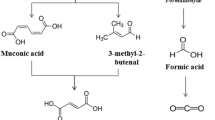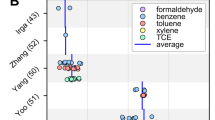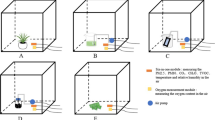Abstract
A unique test chamber system, which enables experiments with plants under highly controlled environmental conditions, was used to examine the pollutant removal efficiency of plants. For this purpose, the removal of two different volatile organic compounds (VOC) (toluene, 2-ethylhexanol) from the air by aerial plant parts of two common indoor plant species (Dieffenbachia maculata and Spathiphyllum wallisii) was monitored. While the control over environmental conditions (temperature, relative humidity, CO2 content, and light condition) worked very well in all experiments, control experiments with the empty chamber revealed high losses of VOC, especially 2-ethylhexanol, over the test duration of 48 h. Nonetheless, compared to the empty chamber, a significantly stronger and more rapid decline in the toluene as well as in the 2-ethylhexanol concentrations was observed when plants were present in the chamber. Interestingly, almost the same VOC removal as by aerial plant parts could be achieved by potting soil without plants. A comparative literature survey revealed substantial heterogeneity in previous results concerning the VOC removal efficiency of plants. This can be mainly attributed to a high diversity in experimental setup. The experimental setup used in the current study offers an excellent opportunity to examine also plant physiological responses to pollutant exposure (or other stressors) under highly controlled conditions. For the analysis of VOC removal under typical indoor conditions, to obtain data for the assessment of realistic VOC removal efficiencies by plants in rooms and offices, a guideline would be helpful to achieve more coherent findings in this field of research.





Similar content being viewed by others
References
Araújo, W. L., Fernie, A. R., & Nunes-Nesi, A. (2011). Control of stomatal aperture: A renaissance of the old guard. Plant Signaling & Behavior, 6(9), 1305–1311. https://doi.org/10.4161/psb.6.9.16425.
Aydogan, A., & Montoya, L. D. (2011). Formaldehyde removal by common indoor plant species and various growing media. Atmospheric Environment, 45, 2675–2682. https://doi.org/10.1016/j.atmosenv.2011.02.062.
Azuma, K., Tanaka-kagawa, T., & Jinno, H. (2016). Health risk assessment of inhalation exposure to 2-ethylhexanol, 2,2,4-trimethyl-1,3-pentanediol diisobutyrate, and texanol in indoor environments. In E. Van Kenhove, J. Laverge, & P. De Vlieger (Eds.), Proceedings: Indoor Air 2016 (p. paper ID 168. Ghent: ISIAQ.
Berrios, I. T., Zhang, J. S., Guo, B., Smith, J., & Zhang, Z. (2005). Volatile organic compounds (VOCS) emissions from sources in a partitioned office environment and their impact on IAQ. In In Tenth International Conference on Indoor Air Quality and Climate (Indoor Air). Beijing: Tsinghua University Press.
Bischof, W., & Bullinger, M. (1998). Indoor conditions and well-being: Interim results from the ProKlimA study. Indoor and Built Environment, 7, 232–233.
Brasche, S., Bullinger, M., Gebhardt, H., Herzog, V., Hornung, P., Kruppa, B., et al. (1999). Factors determining different symptom patterns of sick building syndrome: Results from a multivariate analysis. In G. Raw, C. Aizlewood, & P. Warren (Eds.), Indoor Air ´99. Proceedings of the 8th International Conference Indoor Air Quality Climate (Vol. 5, pp. 402–407). Edinburgh: Construction Research Communications, London.
Burge, P. S. (2004). Sick building syndrome. Occupational and Environmental Medicine, 61, 185–190. https://doi.org/10.1136/oem.2003.008813.
Cape, J. N. (2003). Effects of airborne volatile organic compounds on plants. Environmental Pollution, 122, 145–157.
Chen, W., Zhang, J., & Zhang, Z. (2005). Performance of air cleaners for removing multiple volatile organic compounds in indoor air. American Society of Heating. Refrigerating and Air-Conditioning Engineers (ASHRAE) Transaction, 111, 1101–1114.
Cornejo, J. J., Munoz, F. G., Ma, C. Y., & Stewart, A. J. (1999). Studies on the decontamination of air by plants. Ecotoxicology, 8, 311–320.
Daeumling, C. (2016). Product emissions and the challenges of a harmonized European health evaluation (EU-LCI). In Proceedings of the 14th International Conference of Indoor Air Quality and Climate (p. 167). Ghent.
Dela Cruz, M., Christensen, J. H., Thomsen, J. D., & Müller, R. (2014). Can ornamental potted plants remove volatile organic compounds from indoor air?—a review. Environmental Science and Pollution Research, 21(24), 13909–13928. https://doi.org/10.1007/s11356-014-3240-x.
DIBt - Deutsches Institut für Bautechnik. (2010). Grundsätze zur gesundheitlichen Bewertung von Bauprodukten in Innenräumen. https://www.dibt.de/de/Fachbereiche/data/Aktuelles_Ref_II_4_6.pdf.
Gerbaud, A., & André, M. (1980). Effect of CO2, O2, and light on photosynthesis and photorespiration in wheat. Plant Physiology, 66, 1032–1036.
Giese, M., Bauer-Doranth, U., Langebartels, C., & Sandermann, H. (1994). Detoxification of formaldehyde by the spider plant (Chlorophytum comosum L.) and by soybean (Glycine max L.) cell-suspension cultures. Plant Physiology, 104, 1301–1309.
Guieysse, B., Hort, C., Platel, V., Munoz, R., Ondarts, M., & Revah, S. (2008). Biological treatment of indoor air for VOC removal: Potential and challenges. Biotechnology Advances, 26, 398–410. https://doi.org/10.1016/j.biotechadv.2008.03.005.
Hanoune, B., Nicolas, M., Guilhot, J., Bulteau, G., Cuny, M.-A., & Cuny, D. (2013). Inefficiency of passive plant-based systems for indoor air cleaning. In ASHRAE IAQ 2013 Conference: Environmental Health in Low-Energy Buildings (pp. 31–35). Vancouver.
Irga, P. J., Torpy, F. R., & Burchett, M. D. (2013). Can hydroculture be used to enhance the performance of indoor plants for the removal of air pollutants? Atmospheric Environment, 77, 267–271. https://doi.org/10.1016/j.atmosenv.2013.04.078.
Jen, M. S., Hoylman, A. M., Edwards, N. T., & Walton, B. T. (1995). Experimental method to measure gaseous uptake of 14C-toluene by foliage. Environmental and Experimantal Botany, 35, 389–398.
Jones, A. P. (1999). Indoor air quality and health. Atmospheric Environment, 33, 4535–4564. https://doi.org/10.1016/S1352-2310(99)00272-1.
Kim, K. J., Kil, M. J., Song, J. S., Yoo, E. H., Son, K., & Kays, S. J. (2008). Efficiency of volatile formaldehyde removal by indoor plants: Contribution of aerial plant parts versus the root zone. Journal of the American Society for Horticultural Science, 133, 521–526.
Kvesitadze, E., Sadunishvili, T., & Kvesitadze, G. (2009). Mechanisms of organic contaminants uptake and degradation in plants. World Academy of Science, Engineering and Technology, 3, 417–427.
Liu, Y.-J., Mu, Y.-J., Zhu, Y.-G., Ding, H., & Arens, N. C. (2007). Which ornamental plant species effectively remove benzene from indoor air? Atmospheric Environment, 41, 650–654. https://doi.org/10.1016/j.atmosenv.2006.08.001.
Llewellyn, D., & Dixon, M. (2011). Can plants really improve indoor air quality? In M. M. Young (Ed.), Comprehensive Biotechnology (Second Edi., Vol. 4, pp. 331–338. Oxford: Elsevier B.V. https://doi.org/10.1016/B978-0-08-088504-9.00325-1.
Luengas, A., Barona, A., Hort, C., Gallastegui, G., Platel, V., & Elias, A. (2015). A review of indoor air treatment technologies. Reviews in Environmental Science and Biotechnology, 14(3), 499–522. https://doi.org/10.1007/s11157-015-9363-9.
Massold, E., Bähr, C., Salthammer, T., & Brown, S. K. (2005). Determination of VOC and TVOC in air using thermal desorption GC-MS—practical implications for test chamber experiments. Chromatographia, 62(1–2), 75–85. https://doi.org/10.1365/s10337-005-0582-z.
Nalli, S., Horn, O. J., Grochowalski, A. R., Cooper, D. G., & Nicell, J. A. (2006). Origin of 2-ethylhexanol as a VOC. Environmental Pollution, 140(1), 181–185. https://doi.org/10.1016/j.envpol.2005.06.018.
Orwell, R. L., Wood, R. A., Burchett, M. D., Tarran, J., & Torpy, F. (2006). The potted-plant microcosm substantially reduces indoor air VOC pollution: II. Laboratory study. Water, Air, and Soil Pollution, 177, 59–80. https://doi.org/10.1007/s11270-.
Oyabu, T., Sawada, A., Onodera, T., Takenaka, K., & Wolverton, B. (2003). Characteristics of potted plants for removing offensive odors. Sensors and Actuators B, 89, 131–136. https://doi.org/10.1016/S0925-4005(02)00454-9.
Pärnik, T., Ivanova, H., & Keerberg, O. (2007). Photorespiratory and respiratory decarboxylations in leaves of C 3 plants under different CO2 concentrations and irradiances. Plant, Cell and Environment, 30(12), 1535–1544. https://doi.org/10.1111/j.1365-3040.2007.01725.x.
Paterson, S., Mackay, D., Tam, D., & Shiu, W. Y. (1990). Uptake of organic chemicals by plants: A review of processes, correlations and models. Chemosphere, 21(3), 297–331. https://doi.org/10.1016/0045-6535(90)90002-B.
Porter, J. R. (1994). Toluene removal from air by Dieffenbachia in a closed environment. Advances in Space Research, 14, 99–103. https://doi.org/10.1016/0273-1177(94)90285-2.
Que, Z.-L., Wang, F.-B., Li, J.-Z., & Furuno, T. (2013). Assessment on emission of volatile organic compounds and formaldehyde from building materials. Composites: Part B, 49, 36–42. https://doi.org/10.1016/j.compositesb.2013.01.008.
Reiser, R., Meile, A., Hofer, C., & Knutti, R. (2002). Indoor air pollution by volatile organic compounds (VOC) emitted from flooring material in a technical university in Switzerland. In Proceedings: Indoor Air 2002 (pp. 1004–1009).
Rösch, C., Kohajda, T., Röder, S., von Bergen, M., & Schlink, U. (2014). Relationship between sources and patterns of VOCs in indoor air. Atmospheric Pollution Research, 5(1), 129–137. https://doi.org/10.5094/APR.2014.016.
Rudel, R. A., & Perovich, L. J. (2009). Endocrine disrupting chemicals in indoor and outdoor air. Atmospheric Environment, 43(1), 170–181. https://doi.org/10.1016/j.atmosenv.2008.09.025.
Salthammer, T., & Bahadir, M. (2009). Occurrence, dynamics and reactions of organic pollutants in the indoor environment. Clean - Soil, Air, Water, 37(6), 417–435. https://doi.org/10.1002/clen.200900015.
Sandermann, H. (1992). Plant metabolism of xenobiotics. Trends in Biochemical Sciences, 17, 82–84.
Sarigiannis, D. A., Karakitsios, S. P., Gotti, A., Liakos, I. L., & Katsoyiannis, A. (2011). Exposure to major volatile organic compounds and carbonyls in European indoor environments and associated health risk. Environment International, 37, 743–765. https://doi.org/10.1016/j.envint.2011.01.005.
Schmitz, H., Hilgers, U., & Weidner, M. (2000). Assimilation and metabolism of formaldehyde by leaves appear unlikely to be of value for indoor air purification. New Phytologist, 147, 307–315.
Schulte-Hostede, S., Darrall, N., Blank, L., & Wellburn, A. (1987). Air pollution and plant metabolism. In S. Schulte-Hostede (Ed.). New York: Elsevier Applied Science.
Schweizer, C., Edwards, R. D., Bayer-Oglesby, L., Gauderman, W. J., Ilacqua, V., Juhani Jantunen, M., et al. (2006). Indoor time–microenvironment–activity patterns in seven regions of Europe. Journal of Exposure Science and Environmental Epidemiology, 17(2), 170–181. https://doi.org/10.1038/sj.jes.7500490.
Sriprapat, W., & Thiravetyan, P. (2013). Phytoremediation of BTEX from indoor air by Zamioculcas zamiifolia. Water, Air, and Soil Pollution, 224(1482), 1–9. https://doi.org/10.1007/s11270-013-1482-8.
Terry, N., & Banuelos, G. S. (Eds.). (2000). Phytoremediation of contaminated soil and water. Boca Raton: CRC Press LLC.
Tham, K. W. (2016). Indoor air quality and its effects on humans—a review of challenges and developments in the last 30 years. Energy and Buildings, 130, 637–650. https://doi.org/10.1016/j.enbuild.2016.08.071.
Treesubsuntorn, C., & Thiravetyan, P. (2012). Removal of benzene from indoor air by Dracaena sanderiana: Effect of wax and stomata. Atmospheric Environment, 57, 317–321. https://doi.org/10.1016/j.atmosenv.2012.04.016.
Turner, N. C. (1991). Measurement and influence of environmental and plant factors on stomatal conductance in the field. Agricultural and Forest Meteorology, 54(2–4), 137–154. https://doi.org/10.1016/0168-1923(91)90003-9.
Ugrekhelidze, D., Korte, F., & Kvesitadze, G. (1997). Uptake and transformation of benzene and toluene by plant leaves. Ecotoxicology and Environmental Safety, 37, 24–29. https://doi.org/10.1006/eesa.1996.1512.
Vaughan, T. L., Strader, C., Davis, S., & Daling, J. R. (1986). Formaldehyde and cancers of the pharynx, sinus and nasal cavity: II. Residential exposures. International Journal of Cancer, 38, 685–688.
Vizhemehr, A. K., Haghighat, F., Lee, C.-S., Kholafaei, H., & Lakdawala, N. (2015). Evaluation of gas-phase filter performance for a gas mixture. CLEAN – Soil, Air, Water, 43(4), 469–478. https://doi.org/10.1002/clen.201300751.
Wallace, L. A. (1991). Personal exposure to 25 volatile organic compounds Epa’s 1987 team study in Los Angeles, California. Toxicology and Industrial Health, 7, 203–208. https://doi.org/10.1177/074823379100700523.
Weschler, C. J. (2009). Changes in indoor pollutants since the 1950s. Atmospheric Environment, 43(1), 153–169. https://doi.org/10.1016/j.atmosenv.2008.09.044.
Wetzel, T. A., & Doucette, W. J. (2015). Plant leaves as indoor air passive samplers for volatile organic compounds (VOCs). Chemosphere, 122, 32–37. https://doi.org/10.1016/j.chemosphere.2014.10.065.
Wolkoff, P., & Nielsen, G. D. (2001). Organic compounds in indoor air—their relevance for perceived indoor air quality? Atmospheric Environment, 35, 4407–4417. https://doi.org/10.1016/S1352-2310(01)00244-8.
Wolverton, B. C., McDonald, R. C., & Watkins, E. A. (1984). Foliage plants for removing indoor air pollutants from energy-efficient homes. Economic Botany, 38, 224–228.
Wolverton, B. C., & Wolverton, J. D. (1993). Plants and soil microorganisms: Removal of formaldehyde, xylene, and ammonia from the indoor environment. Journal of the Mississippi Academy of Science, 38, 11–15.
Wood, R. A., Burchett, M. D., Alquezar, R., Orwell, R. L., Tarran, J., & Torpy, F. (2006). The potted-plant microcosm substantially reduces indoor air VOC pollution: I. Office field-study. Water, Air, and Soil Pollution, 175, 163–180. https://doi.org/10.1007/s11270-006-9124-z.
Wood, R. A., Orwell, R. L., Tarran, J., Torpy, F., & Burchett, M. (2002). Potted-plant/growth media interactions and capacities for removal of volatiles from indoor air. Journal of Horticultural Science and Biotechnology, 77, 120–129.
Xu, Z., Wang, L., & Hou, H. (2011). Formaldehyde removal by potted plant-soil systems. Journal of Hazardous Materials, 192, 314–318. https://doi.org/10.1016/j.jhazmat.2011.05.020.
Yang, D. S., Pennisi, S. V., Son, K.-C., & Kays, S. J. (2009). Screening indoor plants for volatile organic pollutant removal efficiency. Hortscience, 44, 1377–1381.
Yoo, M. H., Kwon, Y. J., Son, K., & Kays, S. J. (2006). Efficacy of indoor plants for the removal of single and mixed volatile organic pollutants and physiological effects of the volatiles on the plants. Journal of the American Society for Horticultural Science, 131, 452–458.
Yu, C. W. F., & Kim, J. T. (2010). Building pathology, investigation of sick buildings—VOC emissions. Indoor and Built Environment, 19, 30–39. https://doi.org/10.1177/1420326X09358799.
Acknowledgements
V. H. was funded by a PhD grant from the Elsa-Neumann-Foundation, Berlin, Germany. Sara Schaarschmidt is acknowledged for critically reading the manuscript.
Author information
Authors and Affiliations
Corresponding author
Rights and permissions
About this article
Cite this article
Hörmann, V., Brenske, KR. & Ulrichs, C. Suitability of Test Chambers for Analyzing Air Pollutant Removal by Plants and Assessing Potential Indoor Air Purification. Water Air Soil Pollut 228, 402 (2017). https://doi.org/10.1007/s11270-017-3586-z
Received:
Accepted:
Published:
DOI: https://doi.org/10.1007/s11270-017-3586-z




